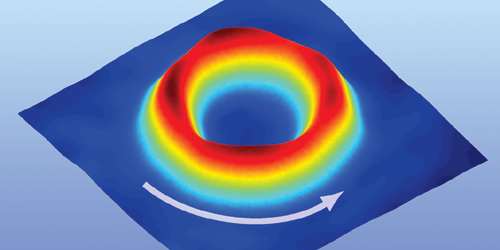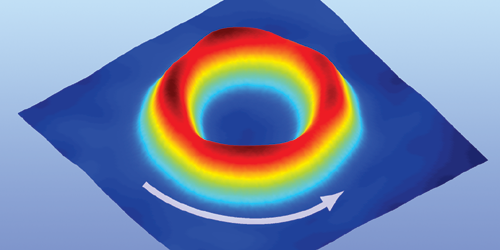Superfluid Doughnut Spins at Supersonic Speeds
Bose-Einstein condensates (BECs) are collective quantum states that form when atoms are cooled to near absolute zero. These states often exhibit the unusual behavior of a fluid with zero viscosity (a superfluid), such as the formation of vortices with quantized angular momentum. Theorists have predicted that, if spun fast enough, the vortices will coalesce into a single giant quantized vortex at the center of the system. Now, in a step toward experimentally creating this giant vortex, Hélène Perrin and colleagues of the French National Center for Scientific Research (CNRS) and the University of Paris 13 have formed the vortex’s predicted precursor stage—a spinning superfluid ring.
To create this superfluid ring, the researchers trapped a BEC consisting of 100,000 rubidium atoms in an egg-shaped potential that they produced using radio frequency fields. Spinning the BEC produced small vortices in its bulk. Beyond a critical rotation speed, a hole formed at the center, making the system resemble a spinning, superfluid doughnut. The small vortices began to migrate toward this hole, which expanded as the researchers increased the BEC’s rotation rate. At its fastest, the quantum fluid moved at 18 times the speed of sound in the medium. The system kept its annular shape for over a minute, during which time the researchers perturbed the shape of the trap to create smaller excitations within the ring. The properties of these smaller excitations disagreed with current theory, so the team aims to study the discrepancy to better understand superfluid flow at a range of critical rotation speeds. Eventually, they hope to create the theoretically predicted giant vortex.
This research is published in Physical Review Letters.
–Sophia Chen
Sophia Chen is a freelance science writer based in Tucson, Arizona.





